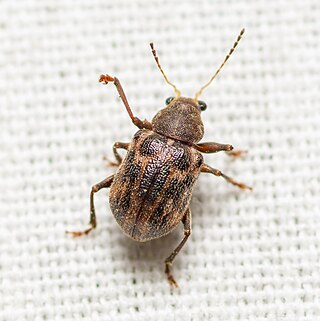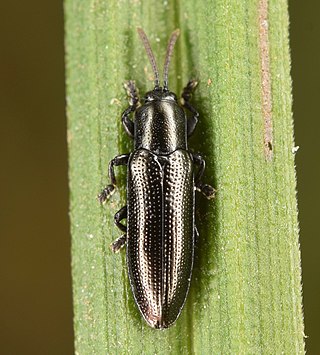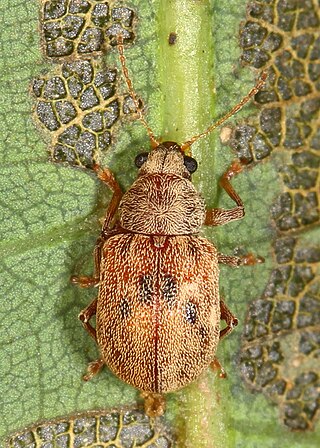
The Eumolpinae are a subfamily of the leaf beetles, or Chrysomelidae. It is one of the largest subfamilies of leaf beetles, including more than 500 genera and 7000 species. They are oval, and convex in form, and measure up to 10 mm in size. Typical coloration for this subfamily of beetles ranges from bright yellow to dark red. Many species are iridescent or brilliantly metallic blue or green in appearance.

Xanthonia is a genus of leaf beetles in the subfamily Eumolpinae. It is distributed in North and Central America, and in East, Southeast and South Asia.

The Spilopyrinae are a small subfamily of the leaf beetles, or Chrysomelidae. They occur in Australia, New Guinea, New Caledonia and Chile. They were formerly considered a tribe of the subfamily Eumolpinae. The group was elevated to subfamily rank by C. A. M. Reid in 2000. However, some authors have criticised this placement, preferring to retain them within the Eumolpinae.

Sumitrosis is a genus of leaf beetles in the family Chrysomelidae. There are at least 60 described species in Sumitrosis.

Chalepini is a tribe of leaf beetles in the family Chrysomelidae. There are at least 50 genera and 830 described species in Chalepini.

Neofidia is a genus of leaf beetles in the subfamily Eumolpinae. It is distributed in North and Central America. There are 24 species recognised in Neofidia.

Stenispa is a genus of tortoise beetles and hispines in the family Chrysomelidae. There are at least 20 described species in Stenispa.
Neofidia clematis is a species of leaf beetle. It is known from southernmost Texas to central Veracruz, Mexico, east of the Sierra Madre Oriental. It was first described by the American entomologist Charles Frederic August Schaeffer in 1904. Two series of this species from Texas were collected from Cissus incisa, a species in the grape family (Vitaceae).

Eumolpini is a tribe of leaf beetles in the subfamily Eumolpinae. It is the largest tribe in the subfamily, with approximately 170 genera found worldwide. Members of the tribe almost always have a longitudinal median groove on the pygidium, which possibly helps to keep the elytra locked at rest. They also generally have a subglabrous body, as well as appendiculate pretarsal claws.
Neofidia texana is a species of leaf beetle that is found in North America. It occurs in central and east-central Texas, and is associated with plants in the grape family (Vitaceae). Neofidia texana was first described as a variety of Fidia viticida by the American entomologist Charles Frederic August Schaeffer in 1934. It is now considered to be a separate species.
Xanthonia furcata is a species of leaf beetle. It is found in North America. It is associated with wild cherry and oaks. The specific name comes from the Latin furca, meaning "fork".

Demotina is a genus of leaf beetles in the subfamily Eumolpinae. There are over 50 described species in Demotina. The genus is native to Asia, Australia and Oceania, though one species is an adventive species in the southeastern United States in North America. Some species are known to be parthenogenetic.
Neofidia humeralis is a species of leaf beetle. It ranges from southeastern Arizona and southwestern New Mexico, along the Sierra Madre Occidental and Sierra Madre del Sur, south to Oaxaca in southwestern Mexico. It was first described as two species, Fidia humeralis and Fidia plagiata, by the French entomologist Édouard Lefèvre in 1877. These two species were later found to be synonymous.
Xanthonia angulata is a species of leaf beetle. It is found in North America. It is associated with oaks. The specific name comes from the Latin angulatus, meaning "with angles".

Typophorini is a tribe of leaf beetles in the subfamily Eumolpinae. The tribe contains approximately 100 genera, which are found worldwide. Members of the tribe are mainly characterized by notches on the tibiae of the middle and hind legs, which are sometimes referred to as antenna cleaners. They also generally have a subglabrous body, as well as bifid pretarsal claws.

Neofidia lurida, the grape rootworm, is a species of leaf beetle. Grape rootworms are found in eastern North America, south to Mexico, and have been recently reported as far north as Quebec. Adults are typically 4.9 to 7.0 mm in length. They are colored mahogany brown, and are covered with white to straw-yellow hairs.

Fidia is a genus of leaf beetles in the subfamily Eumolpinae. It is distributed in East Asia, Southeast Asia and Africa.

Bromiini is a tribe of leaf beetles in the subfamily Eumolpinae. The tribe contains approximately 120 genera, which are found worldwide. They are generally thought to be an artificial group, often with a subcylindrical prothorax without lateral ridges and covered with setae or scales.

Fidia atra is a species of leaf beetle in the family Chrysomelidae. It is distributed in Japan, China, Korea, and the Russian Far East.











